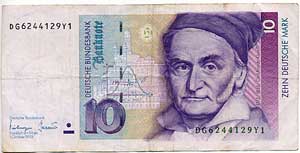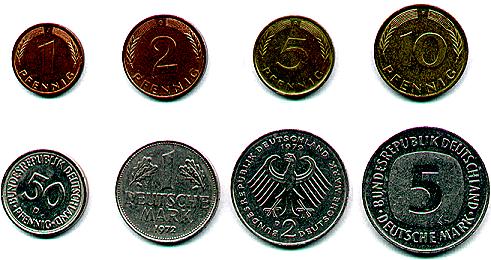Deutsche Mark
|
|

Deutschemarknotes.png
The Deutsche Mark (DM, DEM) was the official currency of West Germany from 1948 until re-unification in 1990 and the official currency of Germany from then until the introduction of the euro in 1999 (coins and notes were withdrawn from circulation in 2002, it is guaranteed by the Deutsche Bundesbank that all DM cash may be changed into Euro forever). One Euro was set to be equivalent to DEM 1.95583. 1 Mark = 100 Pfennig (pennies).
In colloquial German, the 10 Pfennig coin was also called a Groschen.
| Contents |
History
A mark had been the currency of Germany since its original unification in 1871. While the Papiermark of the Weimar Republic underwent hyperinflation until it was replaced by the Rentenmark in late 1923 and the Reichsmark in the following year, the Deutsche Mark was regarded a symbol of West German and subsequently German economic power and stability. In the former GDR the East German mark (Mark der DDR, unofficially Ostmark) was used.
The Deutsche Mark was introduced in 1948 by the Western powers once the post-war division of Germany into East and West seemed permanent. The move, intended to protect West Germany from the second wave of hyperinflation and stop the rampant barter and black market trade (where American cigarettes acted as currency), angered the Russian authorities in East Berlin, who regarded it as a threat and promptly cut off all transport (road, rail and canal) links from West Germany to West Berlin. This led to the Berlin Crisis of 1949.
Coins
The image displays the obverses of all regular coins, with the values of 0.01, 0.02, 0.05, 0.10, 0.50, 1.00, 2.00 and 5.00 DEM (there is no 0.20 coin, and originally there was no 2.00 coin either). 0.01 and 0.02 are copper-colored, 0.05 and 0.10 are brass-colored, the rest are silver-colored. The reverse displays an oak twig (0.01-0.10), a woman planting an oak seedling (0.50), the Bundesadler (German eagle; 1.00 and 5.00) and faces of the German politicians and scientists Konrad Adenauer (Chancellor), Theodor Heuss (President), Franz-Josef Strauss (Minister of Defense), Ludwig Erhard (Chancellor), Kurt Schumacher (Leader of the SPD), Willy Brandt (Chancellor) and Max Planck (Physicist) (2.00). There is a considerable number of commemorative 5 and 10 DEM coins, which actually had the status of legal tender but are rarely seen outside of collectors' circles.
Banknotes
There were three series of DEM banknotes:
- One issued in 1948 by the Bank deutscher Länder, an institution of the western occupation government. The designs were similar to the US Dollar.
- One issued in 1960 by the Bundesbank, depicting neutral symbols and famous paintings and buildings. There were 5, 10, 20, 50, 100, 500 and 1000 DEM denominations.
- One issued in 1989 by the Bundesbank to counter advances in forgery technology. The notes depicted German artists and scientists together with symbols and tools of their trade. This series added a 200 DEM denomination.
In the latter two series, the 5 DEM denomination was rarely seen, as were the ones with a value greater than 100 DEM.
See also
External links
- http://www.bundesbank.de/ — Pictures and descriptions of all the notes and coins (http://www.bundesbank.de/bargeld/bargeld_faq_dm.en.php)
- Overview of German mark from BBC online (http://news.bbc.co.uk/hi/english/static/in_depth/business/2001/euro_cash/spent_currencies/mark.stm)Template:PreEuroCurrencies
da:D-Mark de:Deutsche Mark es:Marco alemán fr:Deutsche Mark id:Deutsche Mark it:Marco tedesco ja:ドイツマルク nl:Duitse mark no:Tysk mark sv:D-mark zh:德國馬克

